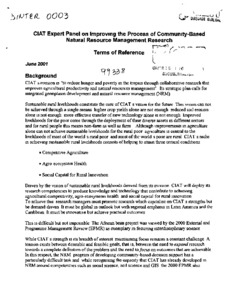CIFOR - using a 'system' approach to research evaluation
The overarching objective for CIFOR is to ensure that research activities result in significant impacts. A secondary, but very important, requirement is to be able to measure and quantify impact. However, impact assessment at CIFOR is viewed as a component in the broader frame of research evaluation and within the dynamic system of identifying problems, planning solutions, producing outputs, promoting adoption, and securing positive outcomes in line with its mission. In the context of this changing environment, adaptation and learning are key institutional requirements.
CIFOR research abstracts 2000
This publication is a collection of the abstracts of in-house and external publications produced in the year 2000 by CIFOR scientists and their collaborators. It also abstracts several publications produced in 1999 that were not able to be included in the 1999 research abstrats. The abstracts are grouped into six themes that represent CIFOR's research activities. Indexes are provided by author and subject.
CIFOR research abstracts 2001
This book is a compilation of the abstracts of in-house and external publications produced in the year 2001 by CIFOR scientists and their collaborators. The abstracts are grouped into seven themes: general, biodiversity, forest governance and community forestry, forest management, non-timber forest products, plantations and rehabilitation of degraded forests, policy and extrasectoral issues that represent CIFOR's research activities. Indexes are provided by author and keyword.
CIFOR research abstracts 2002
This book is a compilation of the abstracts of in-house and external publications produced in the year 2002 by CIFOR scientists and their collaborators. The abstracts are grouped into seven themes: general, biodiversity, forest governance and community forestry, forest management, non-timber forest products, plantations and rehabilitation of degraded forests, policy and extrasectoral issues that represent CIFOR's research activities. Indexes are provided by author and keyword.





